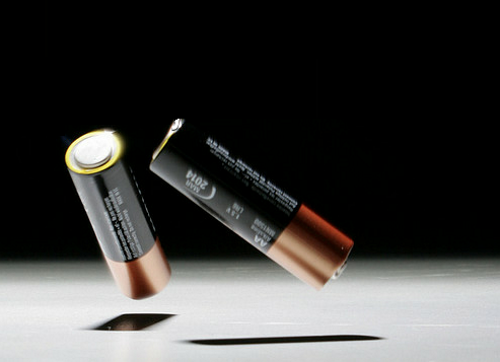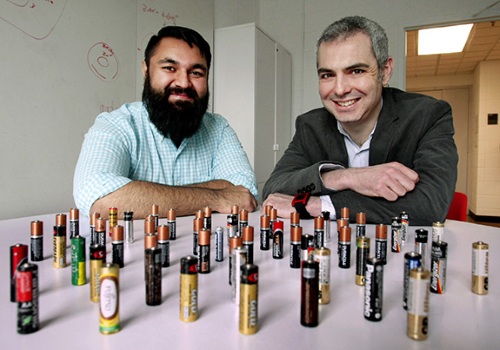In case you missed it, a battery-bounce theory (that’s the only way to describe it) went viral a few months back when a series of videos demonstrating the test were published to YouTube.
In layman’s terms, the theory states that fully charged batteries bounce very little when dropped, while those that have been used for a while bounce higher.
The more the battery is discharged, the higher it bounces. This has led to the commonly accepted conclusion that internal changes relating to the reduction in charge occur within the battery, and this causes it to bounce higher.

Much to the delight of battery manufacturers everywhere, researchers at Princeton University have now officially debunked this theory, saying that dropping one’s battery to the floor and observing how high it bounces is not an effective way to check its charge.
“The bounce does not tell you whether the battery is dead or not, it just tells you whether the battery is fresh,” said Daniel Steingart, an assistant professor of mechanical and aerospace engineering and the Andlinger Center for Energy and the Environment.
 Shoham Bhadra, a doctoral student in electrical engineering and the Andlinger Center for Energy and the Environment (left), and Daniel Steingart, an assistant professor of mechanical and aerospace engineering and the Andlinger Center, found that changes in the bounce of common batteries signal important changes that occur as the battery discharges.
Shoham Bhadra, a doctoral student in electrical engineering and the Andlinger Center for Energy and the Environment (left), and Daniel Steingart, an assistant professor of mechanical and aerospace engineering and the Andlinger Center, found that changes in the bounce of common batteries signal important changes that occur as the battery discharges.
Steingart began looking into the matter after a friend sent him one of the online videos making its way across technology publications and online forums. He had never see the clip, nor had he heard of the theory, but after viewing it, he took out a bunch of batteries and verified it.
The idea that the height with which a battery bounces can be adjusted by the amount it is discharged intrigued Steingart. He became even more curious about it when he noticed after a series of tests that the height of the bounce to level of discharge was not a linear increase; rather, the height rapidly increased before leveling off. His team had been working for a while on internal changes related to battery discharge, and he began to wonder whether the different bounces reflected a change within the batteries themselves.
To study the matter, the group created an experiment in which they dropped a common battery through a plexiglass tube and used a computer microphone to record its striking the benchtop. They then used the time between bounces to determine the height of the bounce.

“What I really loved about this experiment is that the result holds a lot of scientific importance, but it is also the kind of thing I can show to someone without a scientific background and they can still get something out of it,” said Shoham Bhadra, a graduate student in electrical engineering and the Andlinger Center for Energy and the Environment and the lead author of the research paper reporting the findings.
In a different part of the study, the group looked into the materials used in alkaline batteries, gathering data by scanning the batteries with an X-ray machine. They then combined the results of their drop tests with this data to get a better understanding of what caused the changes in bouncing.
The team discovered it had less to do with the amount the battery discharged, and more so with the way in which batteries produce power. You see, electricity is generated by a chemical reaction that occurs inside the batteries (wherein zinc changes to zinc oxide) — a layer of zinc surrounds a brass core in the battery, much like a donut around a hole, and as the battery discharges, the zinc donut slowly changes to zinc oxide.
“The zinc oxide begins to form on the outside and it pushes its way to the core,” Steingart said. “As you get more and more zinc oxide, and the zinc oxide begins to appear everywhere in the zinc layer, the battery gets bouncier and bouncier.”
Looking more closely, the team discovered the increased height with which a battery bounces is due to the fact that the zinc oxide forms small bridges within the zinc material, which decreases the mechanical damping of the battery.
“The zinc starts out as a packed bed of particles that all move very nicely past each other,” Steingart said. “When you oxidize the zinc, it makes bridges between the particles and makes it more like a network of springs. That is what gives the battery its bounce.”
Steingart made an interesting note regarding their study — he said it’s not too surprising that this is the reason discharged batteries bounce, as zinc oxide is often listed in patents as a component to add bounce to golf balls.
What is interesting, though, is that the formatting of the bridges reaches a maximum “bounce height” way before the oxidation of the zinc is complete. This means the bounce will reach its peak and level off before the battery is completely dead.
“While this test seems a parlor trick, the way in which the coefficient of restitution changes provides startling insight to not only what reaction is occurring into the battery, but where the reaction is occurring as a function of state of charge,” Steingart said.
Learn more by reading the team’s article, which was published in the March 13 issue of The Journal of Materials Chemistry A.
Advertisement
Learn more about Electronic Products Magazine





